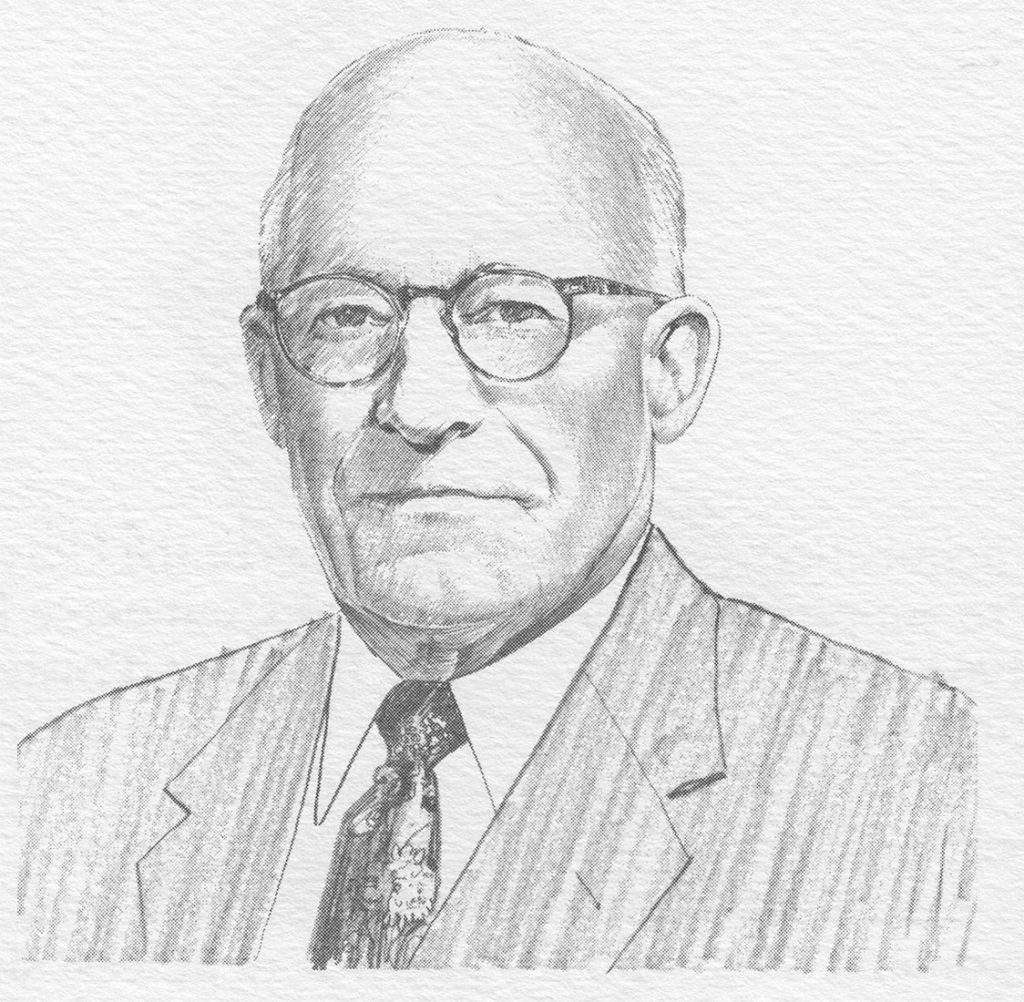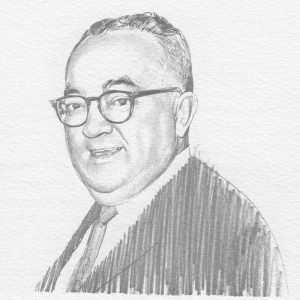Arthur H. Lee and his twin brother Alfred, Anniston – born sons of John B. and Mary N. (Licksold) Lee, began operation of Lee Brothers Foundry in January 1919 with $500 of borrowed money and one helper. When they sold the corporation to Phelps Dodge in 1963 for five and a quarter-million dollars, they had 750 employees, distribution warehouses in ten states, and annual sales of over ten million dollars.
The story of the growth and development of the company reflects the character of Arthur H. Lee.
Mr. Lee and his brother learned early to respect hard work and the people who worked for them. Arthur did the molding, core making, and pouring off during the day, and the office work at night; Alfred operated the furnace, melted brass, and made patterns. They did jobbing work or rough castings for local customers. Since their ambition was to make the best castings possible and to have satisfied customers, Arthur Lee read extensively about the composition of brass and learned how different percentages of the components of the alloy could be used for different end products.
In these early days, the brothers put as much money as possible back into the business to improve it. They increased the floor space in the original building from 1200 to 3600 square feet. About 1923, when they realized that only a finished, not a rough, product was necessary for the company’s continued success, the brothers (unable to afford a $7500 finishing machine that would turn out 400 three-inch brass plugs a day) made a finishing machine from two old lathes. With this machine, total cost about $150, they began finishing about 1,100 brass plugs a day for the soil pipe shops in Anniston. They added two more heads later and had a machine (total cost now $450) that would finish more than 3,500 plugs per day-they learned they could probably make better machines than they could buy.
In the late twenties and early thirties, Arthur and Alfred Lee learned other valuable lessons. In 1927, the brothers agreed to pay installments of $300 per month for $7500 worth of patterns and machines for manufacturing brass fittings. They learned that they had not thought far enough ahead to the set-up and marketing costs before starting to manufacture fittings. They opened their first warehouse in New York City in 1932, but when the banks closed in 1933, they were practically bankrupt and owed the bank about $15,000. When the banks reopened, they tried to reduce their notes as quickly as possible. In doing so in a surprisingly short time, they were able to discount their bills for the first time.
In 1947, the Lee Brothers, then employing 250 people, formed Lee Brothers Foundry Company, Inc., valued at $350,000. By plowing back or through investing all the earnings and profits, they had expanded the plant to 63,000 square feet and used all land space available in the original location.
In June 1950, they bought 102 acres of land across the mountain from Anniston and started plans for a new plant of steel buildings to provide 140,000 square feet of floor space. Their employees designed and built the new plant, including all roads. On a Thursday in August 1951, the 360 employees closed down the old plant at 3:30 p.m. They dismantled, steam cleaned, and painted all equipment (including a ninety-ton sand storage hopper and elevator) and moved it six miles to the new buildings where they installed it. By the following Monday, the new plant opened at fifty percent production on its first day of operation. In a religious ceremony, the new plant was dedicated to the good of the employees and the glory of God.
Always concerned about his employees, Arthur Lee saw a need for them to be able to save money on a timely basis and secure loans at reasonable interest rates. In 1953, he started the Brassies Credit Union which today has 1200 members and assets of over $2.3 million.
In the 1950s, Lee Brothers Company, Inc. continued to grow and expand. The brothers began selling to contract customers and using leased trucks to deliver their products and return with raw materials. They built more warehouses for the distribution of their goods. By 1963, when the corporation was sold-warehouses were operating in Atlanta, Boston, Cincinnati, Dallas, Denver, Los Angeles, Minneapolis, Moline, New York City, Philadelphia, and San Francisco.
As Lee Brothers Foundry prospered, so did others, for Arthur Lee was a man who believed in sharing. With the support of Edna Stoesser, to whom he was married from 1920 until her death in 1951, and of Cecile Thompson, to whom he was married from 1973 until his death, through the years, he was an active participant in community and church affairs.
He served a two-year term as President of the Anniston Chamber of Commerce, a one-year term on the City Council. He was a founder, director, and trustee of the Anniston’s Boy’s Club and a founder of The Anniston Rescue Squad. He was a member of the Anniston Airport Board for several years and a member of the Anniston Rotary Club for twenty-eight years.
Mr. Lee served for fifty years on the Administrative Board, Finance Committee, and Music Committee for the First United Methodist Church of Anniston. He was a talented vocalist who sang in the choir and was a soloist many times during these years.
In 1966, Mr. Lee purchased the former Camp Zinn for Boy Scouts, developed it into a church camping facility, and gave it, along with certain funds for its operation, to the First United Methodist Church of Anniston for non-denominational use. The camp, since named Camp Lee in his honor, was also willed other funds and Mr. Lee’s adjoining farm property and home.
Arthur Lee’s contributions to his community and church were recognized by numerous awards. In 1963, he received the “Aristocrat Award” for his many years of service to the city’s airways development. In 1969, he was named “Anniston’s Man of the Year.” In 1970, he was chosen for membership in the United Methodist Church Hall of Fame in Philanthropy, an award given annually to persons who have given outstanding contributions of service or funds to health and welfare agencies related to the church. In 1971, he was given the Religious Award by the Anniston Kiwanis Club for service rendered to God, Community, and Country. In 1974, he was named Honorary Life Member of the Music Committee of his church for his loyal contributions of time, talent, and means to the music ministry.
An excerpt from an editorial in The Anniston Star at the time of Arthur Henry Lee’s death perhaps summarizes best his meaningful life: “Lee Brothers [Foundry] prospered and grew and so did others. Arthur Lee shared the work . . . [but] the public knows only partly [how] he shared the benefits. When it came to public need, Mr. Lee was not only among the first to subscribe, but he also could-and did – twist arms effectively for the support he felt was essential. Not so well known, however, was his private generosity, the uncounted times he quietly extended help for young people who wanted to go to school, for someone desperate for a friendly hand in time of need. For all the powers he might have wielded, all the honors that came his way, he walked quietly among us, a good and selfless man whose monuments stand all around us.”






